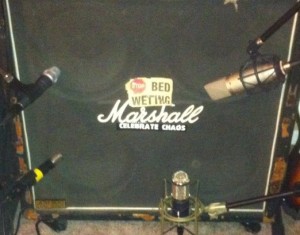In part two of the series let’s take a look at another crucial element for recording guitars, the microphone.
Just as a speaker plays a large role in the sound of an amp, the microphones used to record it are just as important to getting that tone into a recording. And just like speakers, all microphones have a different sound. Huge differences in sound can be heard even in mics that sell for the same price so experimentation is key when looking for a mic (or mics) to capture your golden tone.
So put on your ear goggles and let’s listen to some mics! For this experiment I used eight different microphones of varying types and prices and each has it’s own personal sound. For all examples the guitar used is an SG with a Burstbucker 2 pickup in bridge position. The amp is a Jet City JC20H 20w tube head and the speaker cabinet is an early 80’s Marshall JCM800 closed back 4×12 loaded with Celestion G12T-75 speakers. All mics were placed directly in front of the speakers roughly focused between the center cone and the outer edge at a 45deg angle. All mics are using a cardioid pickup pattern with the exception of the ribbon mic which has a fixed figure 8 pattern, directly run to a Roland OCTA-CAPTURE and recorded in SONAR X1 Producer Expanded at 44.1/16. No settings were changed on the amp or guitar during the recordings and no processing or eq was applied to the tracks.
Click on the links below the model names to hear the mics.
Here are the culprits broken into three types:
Dynamic– dynamic mics work really well with loud volumes due to the ruggedness of the diaphragm used to receive the sound waves coming from the speaker. Since it takes more air pressure to move the diaphragm, less background sounds are picked up putting more focus on the target.
Sennheiser e609 street price $110
Sennheiser MD421 street price $380
Shure Sm57 street price $100
Shure Beta57 street price $140
Audix I5 street price $100
Condenser- condenser mics are more sensitive than their dynamic brethren due to a micro thin diaphragm that is electrically charged with 48volts or “phantom power”. Because of their high sensitivity to air pressure, these mics are great for capturing a wide frequency range and detail of the source being recorded. They are also more likely to pick up background sounds and caution should be used with high decibel levels as some of these mics can be damaged by the extreme air pressure of loud volumes.
Groove Tubes GT67 tube powered large diaphragm street price $700
Sterling Audio ST31 small diaphragm street price $100
Ribbon- ribbon mics are different from the pack in that they use a thin, usually corrugated metal ribbon suspended in a magnetic field to capture sound. Because of this they tend to have a warmer sound that’s less harsh in the high frequencies than condenser mics. Extreme caution should be used with ribbon mics as some can be damaged easily by high volumes. Ribbon mics can also be damaged by 48 volt phantom power so make sure this is turned off before plugging the mic into an input.
MXL R144 street price $100
So there you have it, as you can hear all of the mics have their own individual sound regardless of type and price. In the end, the amp being recorded and your own ear should be the deciding factor on which mic to use. A mic that sounds great on one amp may not sound as good on another one so try out a few prospects with your setup if it’s possible and find the right mic for your amp.
Another cool technique to try if multiple mics are available is using more than one mic to record your amp. Mixing the different tonal characteristics together can sometimes create larger, fuller tones and by inverting the phase on one of the mics even more tones can be created!
To try this out, right click on the sound examples above and select “save as”. Then save the .WAV files to a folder, drag them into an empty project in SONAR and have fun experimenting with different combinations!
Learn more about the world of music creation in SONAR and watch free HD videos on CakeTV


